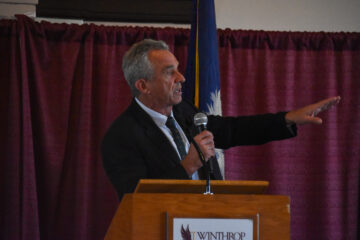Many students here at Winthrop may have heard about recent incidents in South Carolina related to nuclear energy. Over the past year, state newspapers have been reporting controversy surrounding the cancellation of the V.C. Summer expansion, and the Department of Energy’s decision to defund the MOX facility at Savannah River Site. More pressing to citizen’s concerns is the report of multiple Uranium leaks at a Westinghouse-owned fuel production facility near Hopkins, South Carolina just downstream of the state capital of Columbia. As a result, many South Carolinians are outraged, or concerned about whether they have consumed “contaminated” water. Throw on top of this the recent announcement claiming a death is being attributed to radiation from the Fukushima Daiichi nuclear accident by the Japanese government, and anti-nuclear activists are throwing their full arsenal of cherry–picked data and counterfactual information at the public. But let’s look at the facts about Uranium, radiation, and the recent incident in Richland county.
The fuel production facility in Hopkins, South Carolina is one of only three in the US that makes nuclear fuel for our nation’s 99 commercial nuclear reactors. The Uranium fuel production process utilizes some hazardous chemicals: in the most recent incident hydrofluoric acid created a 2-inch hole in the cement and deposited Uranium in approximately six cubic feet of soil, at concentrations up to 4000 parts per million (ppm), or about 0.4%. For reference, this is higher than ocean water, which has a natural concentration of 3 parts per billion (0.003 ppm), but lower than the highest concentrations of Uranium in rock, in the Athabasca basin in Canada, where they reach 17-18% (up to 180,000 ppm). Of the three leaks at the Westinghouse fuel production facility, none of them reached groundwater according to the South Carolina Department of Health and Environmental Control.
But citizens are asking: what if they did reach groundwater and what if someone had been exposed? We actually have data on the effects of Uranium Hexafluoride exposure from leaks at fuel production facilities, which can be found in the NCBI Toxological Report: these studies found that death was caused not by Uranium, but aerosolized Hydrofluoric acid. Likewise, Uranium inhalation by Uranium miners has been studied extensively and higher cancer and death rates have been found, but these studies did not rule out smoking or secondhand smoke, crystalline silica, or diesel exhaust as factors. They also largely attributed the cancer not to Uranium, but Radon gas. Therefore, South Carolinians have little to be concerned about, unless directly ingesting or inhaling large quantities of Uranium hexafluoride, in which event the chemical effects would kill you long before the Uranium did.
But what about radiation from Uranium? Radiation can best be compared to medicine: most doses are safe, but you can overdose, which can harm you. The average American receives about 3.1 millisieverts (mSv) of Radiation every year. This is best conceptualized in the “banana equivalent dose,” or how much radiation you’d receive from the Potassium-40 in the average banana by consuming one. Every year, the average person receives about 31,000 bananas worth of radiation from natural sources. All of us here at Winthrop are also about 8 miles from the Catawba Nuclear Station, from which every year we receive an equivalent dose of a little under 1 banana’s worth. Sleeping next to a chunk of high-grade Uranium ore, or the contaminated soil from the Westinghouse facility, would net you a dose of about 10 bananas in a year. In order to put this into context, a dose equivalent to eating 1,000,000 bananas in a short period, or 100 mSv, is considered the lowest dosage associated with a chance of negative health effects by all major governmental and scientific bodies. The man from Fukushima, whom I mentioned earlier, received approximately 74 mSv in one year of exposure. It is generally agreed that the human body can take up to 250 mSv of cumulative exposure in one year with no negative health impacts. Leading radiation scientist Dr. Geraldine Thomas, who specializes in Chernobyl-related cancers, has stated that his death can most likely be attributed to secondhand smoke or other chemical exposure, not radiation.
In conclusion, South Carolina citizens have no reason to concern themselves with being endangered by these mistakes made at Westinghouse’s fuel production facility. The Nuclear Regulatory Commission, in response to the fact one of the three leaks occurred in 2008 and was left unreported, has stepped in to conduct an environmental study of the site, in order to determine if the company’s negligence requires further reprimand. In most other industries, such events would not warrant the level of scrutiny nuclear power receives. High standards keep the nuclear industry safe, to the point where they have impeded our attempts to construct new reactors in recent years, and it is a clean, safe, and reliable method of energy production. South Carolina citizens, therefore, should support proper oversight of the facility, but also support continued operation and expansion of nuclear facilities in South Carolina, and have no reason to fear for their safety from recent events.
Contributor: Evan Schultheis




